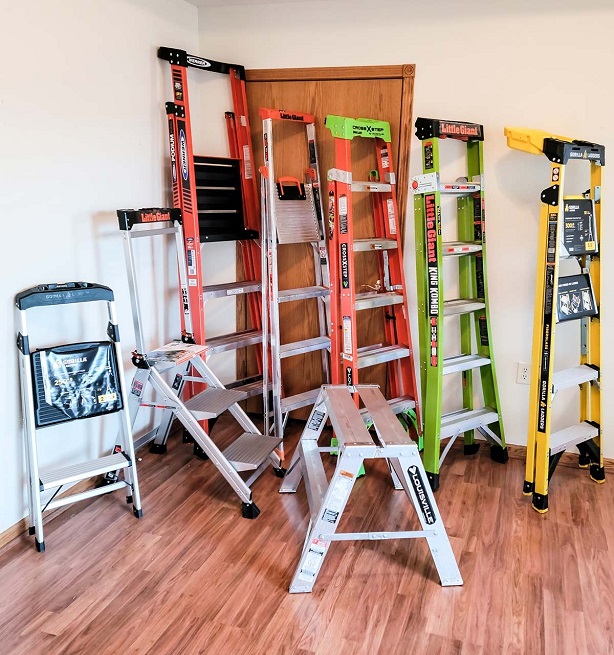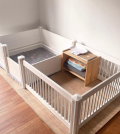8 Different Types of Ladders and Their Uses
Ladders are indispensable for repairs and routine industrial use, allowing you to access all areas of your business. Choosing the right one for work needs consideration of factors beyond convenience since accidents involving a ladder with the incorrect duty grade or application can be lethal. Understanding the numerous types of available models, as well as their applications, load ratings, and features, will help you determine which types to use for your business or in different parts of your warehouse.
Contents
Step Ladder Stool

If you are a business owner searching for an everyday-use tool, then a reliable step ladder stool is your best option. It has two sides and is hence self-supporting. Consequently, they are quite popular among both home and business users. Depending on the design of the two sides, they can be further divided into Front Step Ladders and Twin Step Ladders. As the name implies, we must only utilise the front side steps/rungs to ascend, while the back side serves just as additional support.
Both sides of the twin-step model include steps/rungs, allowing you to ascend from either side. This is especially beneficial if two persons must climb simultaneously. Most of them offer a flat surface for storing tools or a toolbox. To reach a top shelf or replace a light bulb, you must choose the correct size step option due to its predetermined height.
Most models come equipped with extra features for convenience and safety, such as a platform or tray for keeping tools close at hand, wide steps/rungs for easy climbing, and a pair of end caps that protect the user from slipping or falling. Remember to look out for the ANSI load rating when purchasing a step ladder so that it is capable of supporting the weight of an individual.
Depending on the type, they can be stored in even the smallest of spaces, often upright and leaning against a wall. Some models come with slip-resistant rubber feet, which allow them to be used indoors or outdoors without the worry of instability or an accidental slip. This results in a safer and more secure working environment.
Straight Ladder
This is the original tool from the time when bamboo frames were used. It is one of the most straightforward ladders, consisting of two parallel long beams/rails with several levels in between. This model must be supported by a surface (wall or pole) as it lacks a second side (which most modern types have).
There are modern versions of straight ladders with wheels at the base for portability (you can find comparable ones in libraries), but you must descend before repositioning it. In addition to the need for a stable surface, straight varieties are ideal for building, gutter cleaning, and other maintenance tasks.
Basic Extension Ladder
The preceding two options, as well as the majority of future models, have a fixed length, i.e., a predetermined number of steps/rungs. However, the length of a basic extension ladder can be extended to double (or triple) the number of steps/rungs. It employs guided tracks to modify the length and teeth to fixate the height. The majority of them are straight ladders without a built-in support system, which is an essential characteristic.
Platform Ladder
Essentially, this is a step ladder with a slightly altered step structure. The steps/rungs on a standard model can be relatively narrow, making it difficult to stand or maintain your stance. The steps of a platform option are very wide, similar to stairs. This makes it quite easy to stand on the it for extended periods of time.
In addition, the top step serves as a spacious platform for standing or placing goods. Some platform ladders include very durable guard rails that extend over the platform so that you can hold them to change your posture or ascend and descend with ease.
Trestle Ladder
We already discussed twin-step ladders. A trestle ladder is comparable in that it can hold two persons at once. Similarly to step models, they are self-supporting. Even though a single person can utilise a trestle ladder, two people must use caution when using this tool.
We recommend that you ascend and descend simultaneously to preserve your equilibrium. As two individuals may operate in close proximity, these models are advantageous for an appliance or art installation, painting, and retail décor.
Multipurpose Ladder
As the name implies, a multipurpose or multi-way ladder can serve multiple purposes. Some of them can have up to twenty-four distinct functions, including step ladders, extension ladders, trestle ladders, etc. This can be self-supporting or require a robust supporting surface, depending on its intended application. This option is typically better suited for building work, contractors, and skilled handymen.
Telescopic Ladder
A telescopic ladder is a form of an extension that can be collapsed or extended to a certain length with ease. When all the telescoping beams have collapsed, the device becomes incredibly compact and is therefore simple to store. There are some telescopic options that may be transformed into twin-step ones for self-sustenance, while straight options make up the majority of telescopic varieties.
Flexible Ladder
This one is significantly different from the other types we have seen, which all have rigid frames. It is composed of easily rollable rope (natural fibre, metal strings, or similar material). You may have seen in movies or on television a helicopter dropping a ladder to rescue people in an emergency. Aside from such emergency escapes and a few recreational pursuits, a flexible rope is rarely used for other tasks.






